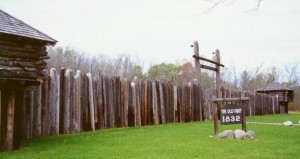Good morning.
Midweek in Whitewater will be sunny with a high of seventy-nine, with northwest winds at 10 to 15 mph.

Revival of the Passenger Pigeon? is a post over at the History Channel’s website. Sarah Pruitt writes about the possibility of reviving that now-extinct species:
The passenger pigeon (Ectopistes migratorius) was once one of North America’s most abundant bird species, numbering some 3 to 5 billion at the time European settlers first set foot on the continent. Early explorers and settlers wrote of their sheer numbers; the 17th-century Massachusetts minister Cotton Mather once described a flock stretching one mile across and taking more than an hour to pass by. Yet thanks to rampant overhunting in the 1800s, as well as loss of its natural forest habitats, the pigeon had disappeared from the wild by 1900. The last known passenger pigeon, named for Martha Washington, died in captivity in the Cincinnati Zoo in 1914….
Now, nearly a century after Martha’s death, scientists believe they can bring her species back to life, using techniques worthy of the 1990s science-fiction/action blockbuster “Jurassic Park.” With funding from Revive and Restore, a group dedicated to the de-extinction of recently lost species, the young biologist Ben J. Novak is spearheading efforts to use DNA taken from passenger pigeon specimens in museums and fill it in with fragments from a living species, the band-tailed pigeon. The reconstituted genome would then be inserted into a band-tailed pigeon stem cell, creating a germ cell (an egg-and-sperm precursor). When the germ cell is injected into young band-tailed pigeons and these pigeons reproduce, their offspring would come as close as possible to expressing the passenger pigeon genes. The “de-extinction” process is different from cloning, in that it uses a variety of DNA from different passenger pigeons, meaning that the offspring produced would be as unique as any bird from an original passenger pigeon flock.
Most experts acknowledge that recreating the passenger pigeon in this way is technically possible, based on the success scientists have had mapping the woolly mammoth genome by using elephant DNA, among other experiments. But significant challenges still exist, particularly when it comes to reintroducing the passenger pigeon into the wild, given the vastly different ecosystem it would encounter in the modern world….
There will never be flocks as there once were, but it’s still an effort, I think, worth undertaking to revive even small numbers of the species.

On this day in 1832, General Atkinson begins construction of a fort during the Black Hawk War:
On this date General Henry Atkinson and his troops built Fort Koshkonong after being forced backwards from the bog area of the “trembling lands” in their pursuit of Black Hawk. The Fort, later known as Fort Atkinson, was described by Atkinson as “a stockade work flanked by four block houses for the security of our supplies and the accommodation of the sick.” It was also on this date that Atkinson discharged a large number of Volunteers from his army in order to decrease stress on a dwindling food supply and to make his force less cumbersome.
One of the dismissed volunteers was future president, Abraham Lincoln, whose horse was stolen in Cold Spring, Wisconsin, and was forced to return to New Salem, Illinois by foot and canoe. [Sources: History Just Ahead: A Guide to Wisconsin’s Historical Markers edited by Sarah Davis McBride and Along the Black Hawk Trail by Willilam F. Stark]
Puzzability‘s series this week is called Fruit Salad:
Fruit Salad
For a refreshing summer dessert this week, just mix and serve. For each day, we’ve taken the name of a kind of fruit, added a letter, and scrambled all the letters to get a new word. The answer phrase, described by each day’s clue, is the new word followed by the fruit name.
Example:
Citrus fruit turned to a lava-like liquid
Answer:
Molten lemon
Here’s the puzzle for Wednesday:
Burn up a peach-like fruit
